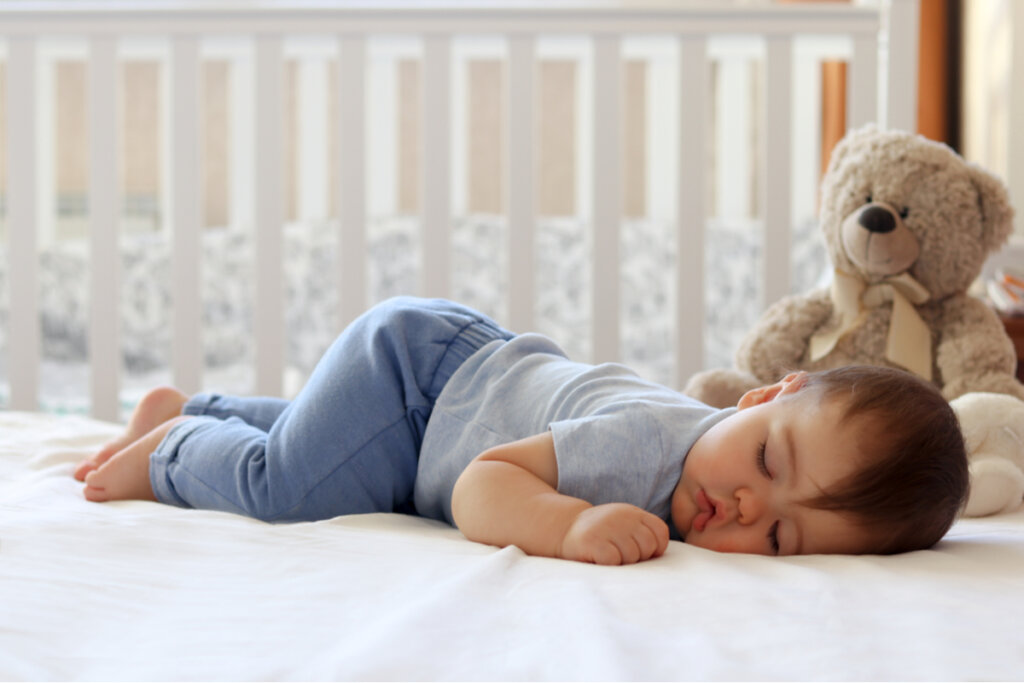Sleep Apnea in Children

Sleep apnea in children is a respiratory condition that always requires attention. In fact, according to the Spanish Association of Primary Care Pediatrics, it has a prevalence of ten percent among the child population. Sometimes, this figure might be even higher. In many cases, it’s caused by enlarged tonsils or adenoids.
Although apnea is a recurring sleep disorder among adults, it continues to be underdiagnosed. That’s because many people assume that snoring is normal and therefore irrelevant. However, what the individual is experiencing are short respiratory arrests. These can cause a lack of oxygen to the brain, heart disease, hypertension, etc.
In children, this condition can be more serious than in adults. For this reason, it’s decisive that parents and caregivers attend to the quality of sleep of their children from early on. It’s estimated that the disorder initially appears before the age of five. It presents with more complex symptoms than in older people.
The effects of not diagnosing sleep apnea early in children include cardiopulmonary problems, daytime sleepiness, inflammatory diseases, etc.

The symptoms of sleep apnea in children
Sleep apnea in children consists of continuous breathing failure episodes during their nightly rest. In fact, their upper respiratory tract is obstructed for between eight and ten seconds.
An investigation conducted by the University Hospital of Oulu (Finland) claims that any child who snores can suffer from obstructive sleep apnea. The researchers discovered that sometimes, children under the age of two exhibited conspicuous snoring while sleeping. However, it isn’t so easy to carry out a diagnosis. This is because various tests are required to differentiate the condition from primary snoring (common and non-pathological).
Main characteristics of sleep apnea in children
Snoring or noisy breathing is the most common symptom of sleep apnea in children. This can appear in babies as young as a few months.
Research conducted by the Harvard Medical School in Boston and the Southwestern Medical Center of the University of Texas (USA) claims that some infants have both an anatomical and physiologic predisposition toward airway obstruction. This can hinder their growth due to a lack of oxygenation. In certain cases, it may even lie behind sudden deaths. Therefore, if a baby snores, it’s important to consult a pediatrician.
In addition to snoring, children between two and ten years of age often experience the following:
- Bedwetting.
- Daytime exhaustion.
- Lack of concentration.
- Irritability and bad mood.
- Headache.
- Sweating.
The causes of sleep apnea in children
There are various origins of sleep apnea in children. The most common is enlarged tonsils or adenoids. These problems can be solved with common surgical interventions.
Other factors associated with this respiratory and sleep disorder are as follows:
- Congenital abnormalities of the respiratory tract. Examples of this are laryngomalacia, pyriform aperture stenosis, hemangiomas, etc.
- Childhood obesity.
- Down syndrome and Pierre Robin sequence.
Diagnosis
When it comes to knowing if a child is suffering from obstructive sleep apnea, it’s not enough just to know that they snore. In fact, there are more variables that medics must clinically analyze to make an accurate diagnosis:
- The most common test performed is sleep polysomnography. It consists of recording, over one or several nights, the child’s brain waves, heart and respiratory rates, oxygen levels in the blood, and movements of their eyes and legs.
- Urinary biomarkers and rhinomanometry.

Treatment for obstructive sleep apnea in children
The treatment of this condition depends on each individual case. For example, some children will only require simple intervention on their tonsils while others may need to lose weight so that their breathing improves. However, the most important thing is to go to the pediatrician and a pediatric otolaryngologist to find out the best treatment.
As with adults, the most widely used technique is positive airway pressure (PAP) treatment. It involves sleeping connected to a machine that keeps the trachea open, thanks to the constant pumping of air under pressure into the airways of the lungs.
Finally, we should remember that snoring isn’t always normal. Without a doubt, understanding its origins and following medical guidelines will improve the sufferer’s quality of life. In children, this issue is even more important.
Sleep apnea in children is a respiratory condition that always requires attention. In fact, according to the Spanish Association of Primary Care Pediatrics, it has a prevalence of ten percent among the child population. Sometimes, this figure might be even higher. In many cases, it’s caused by enlarged tonsils or adenoids.
Although apnea is a recurring sleep disorder among adults, it continues to be underdiagnosed. That’s because many people assume that snoring is normal and therefore irrelevant. However, what the individual is experiencing are short respiratory arrests. These can cause a lack of oxygen to the brain, heart disease, hypertension, etc.
In children, this condition can be more serious than in adults. For this reason, it’s decisive that parents and caregivers attend to the quality of sleep of their children from early on. It’s estimated that the disorder initially appears before the age of five. It presents with more complex symptoms than in older people.
The effects of not diagnosing sleep apnea early in children include cardiopulmonary problems, daytime sleepiness, inflammatory diseases, etc.

The symptoms of sleep apnea in children
Sleep apnea in children consists of continuous breathing failure episodes during their nightly rest. In fact, their upper respiratory tract is obstructed for between eight and ten seconds.
An investigation conducted by the University Hospital of Oulu (Finland) claims that any child who snores can suffer from obstructive sleep apnea. The researchers discovered that sometimes, children under the age of two exhibited conspicuous snoring while sleeping. However, it isn’t so easy to carry out a diagnosis. This is because various tests are required to differentiate the condition from primary snoring (common and non-pathological).
Main characteristics of sleep apnea in children
Snoring or noisy breathing is the most common symptom of sleep apnea in children. This can appear in babies as young as a few months.
Research conducted by the Harvard Medical School in Boston and the Southwestern Medical Center of the University of Texas (USA) claims that some infants have both an anatomical and physiologic predisposition toward airway obstruction. This can hinder their growth due to a lack of oxygenation. In certain cases, it may even lie behind sudden deaths. Therefore, if a baby snores, it’s important to consult a pediatrician.
In addition to snoring, children between two and ten years of age often experience the following:
- Bedwetting.
- Daytime exhaustion.
- Lack of concentration.
- Irritability and bad mood.
- Headache.
- Sweating.
The causes of sleep apnea in children
There are various origins of sleep apnea in children. The most common is enlarged tonsils or adenoids. These problems can be solved with common surgical interventions.
Other factors associated with this respiratory and sleep disorder are as follows:
- Congenital abnormalities of the respiratory tract. Examples of this are laryngomalacia, pyriform aperture stenosis, hemangiomas, etc.
- Childhood obesity.
- Down syndrome and Pierre Robin sequence.
Diagnosis
When it comes to knowing if a child is suffering from obstructive sleep apnea, it’s not enough just to know that they snore. In fact, there are more variables that medics must clinically analyze to make an accurate diagnosis:
- The most common test performed is sleep polysomnography. It consists of recording, over one or several nights, the child’s brain waves, heart and respiratory rates, oxygen levels in the blood, and movements of their eyes and legs.
- Urinary biomarkers and rhinomanometry.

Treatment for obstructive sleep apnea in children
The treatment of this condition depends on each individual case. For example, some children will only require simple intervention on their tonsils while others may need to lose weight so that their breathing improves. However, the most important thing is to go to the pediatrician and a pediatric otolaryngologist to find out the best treatment.
As with adults, the most widely used technique is positive airway pressure (PAP) treatment. It involves sleeping connected to a machine that keeps the trachea open, thanks to the constant pumping of air under pressure into the airways of the lungs.
Finally, we should remember that snoring isn’t always normal. Without a doubt, understanding its origins and following medical guidelines will improve the sufferer’s quality of life. In children, this issue is even more important.
All cited sources were thoroughly reviewed by our team to ensure their quality, reliability, currency, and validity. The bibliography of this article was considered reliable and of academic or scientific accuracy.
- Brockmann PE, Schaefer C, Poets A, Poets CF, Urschitz MS. Diagnosis of obstructive sleep apnea in children: a systematic review. Sleep Med Rev. 2013 Oct;17(5):331-40. doi: 10.1016/j.smrv.2012.08.004. Epub 2013 Jan 30. PMID: 23375659.
- Nieminen P, Tolonen U, Löppönen H. Snoring and Obstructive Sleep Apnea in Children: A 6-Month Follow-up Study. Arch Otolaryngol Head Neck Surg. 2000;126(4):481–486. doi:10.1001/archotol.126.4.481
This text is provided for informational purposes only and does not replace consultation with a professional. If in doubt, consult your specialist.







